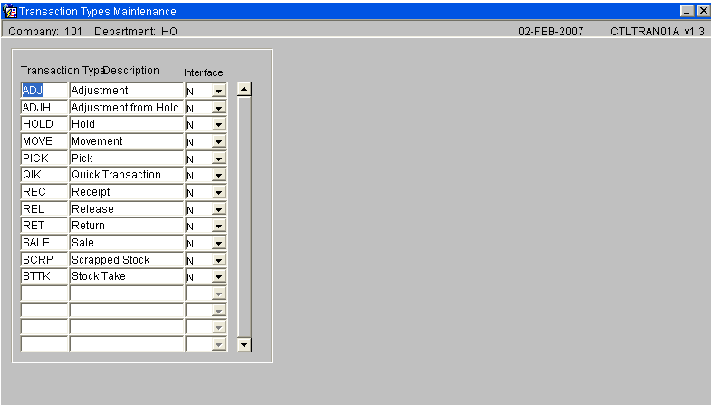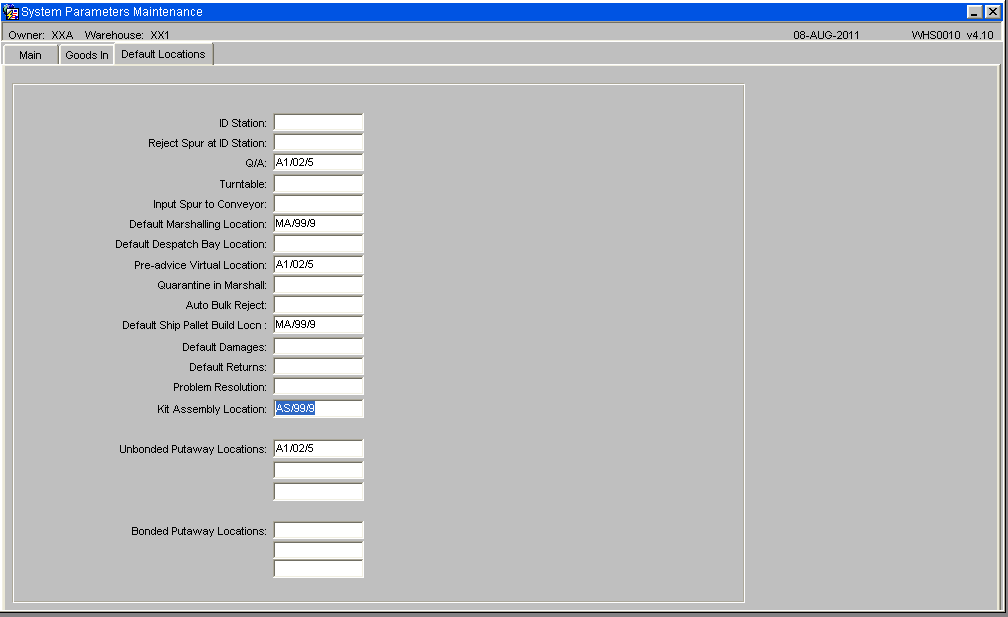UG 352167 C-WMS Kitting Setup and Process Guide
![]()
Aptean
C-WMS Kitting Setup and Processing Guide
CALIDUS WMS
30th April 2025 - 2.0
Reference: FS UG 352167
Kitting Setup and Processing Guide
System Set Up
Transaction Types Maintenance (CTLTRAN01A)
Ensure that there is a 'ADJK' (Adjustment Kitting) record in the Transaction Types Maintenance screen
This screen only has to be amended/created if wanting to use the Transactions Report. The system will automatically generate the Transaction Types when processing. Note, some of the Transaction Types are already created when opening this screen. The values below are the default types.
![]() Note:
Note:
- The Transaction denotes each system or user generated transaction type during all processes
- The Interface flag is used is client specific EDI Processing
System Parameters (WHS0010)
To raise an assembly order request, an assembly location must be set against the warehouse in the System Parameters – Default Locations tab. The field will be labelled, ‘Assembly Location’. Kits will be assembled and stored in this location.
The other fields in the System Parameters screen are documented in Warehouse Set Up
Owner Maintenance (STS1000)
To raise an assembly order request, a default customer must be set against the owner record in the Owner Maintenance screen.
The other fields in Owner Maintenance are documented in Owner Maintenance
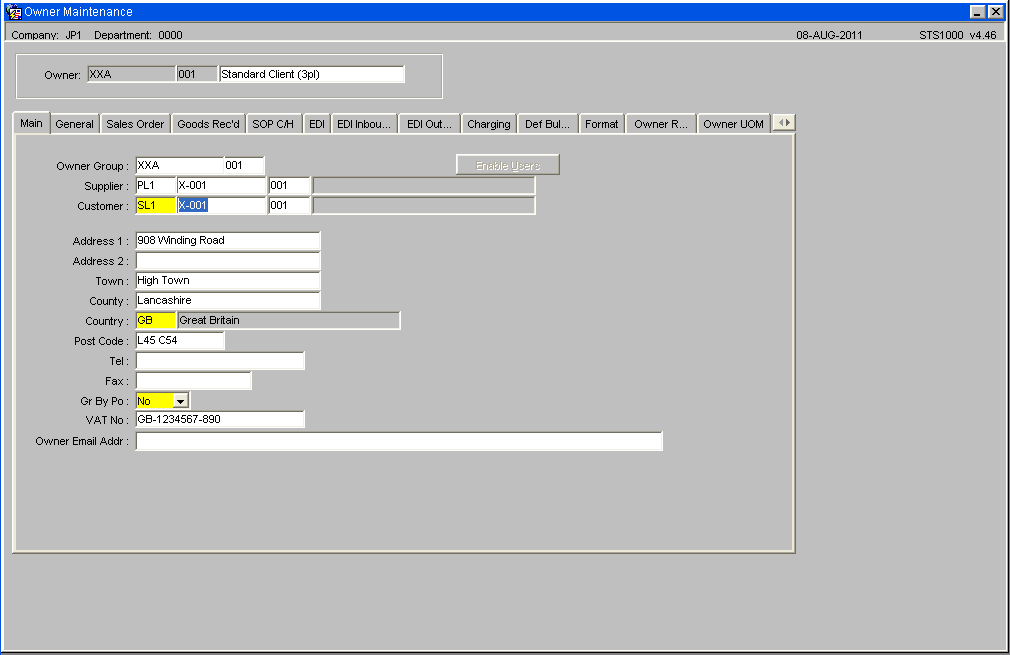
Stock Maintenance (STKSTOC01B)
Stock kit codes are created in the same way as ordinary stock codes. To define a Stock Code as a Stock Kit, the field ‘Sales Kit’ should be set to ‘Yes’ in the Stock Maintenance screen.
Component stock codes are also created in the same way as ordinary stock codes. To define a Stock Code as a component, the field ‘Sales Kit’ should be set to ‘No’ in the Stock Maintenance screen. The ‘Sales Kit’ should be set to ‘Both’ in the Stock Maintenance screen so that the stock item can be both a master kit item and a component of a kit. The other fields in the Stock Maintenance screen are documented in Stock Set Up
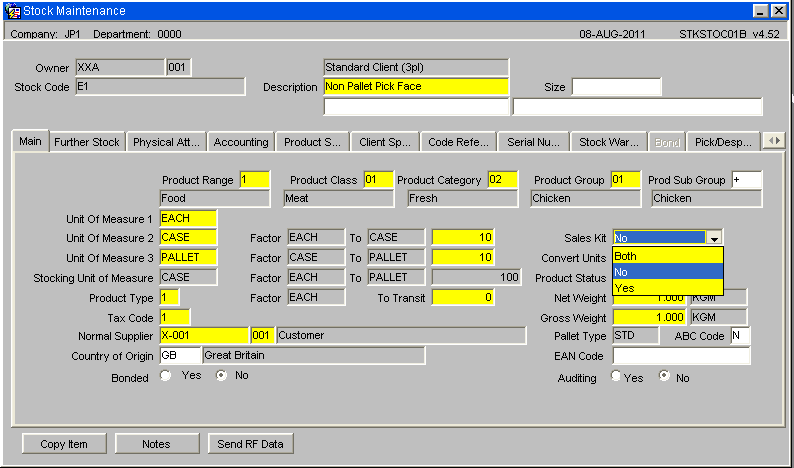
Kitting Process
Stock items will be identified as either kits or components of kits. Components will be associated with kits by assigning each component to the kit in a new Stock Kit Maintenance screen. Components may be applied to many kits or sold as individual items. The three stages to this process are as follows:
- Stock Kits Maintenance CSS0290
- Stock Kits Assembly Request SOS1427
- Stock Kits Assembly Confirmation SOS1428
The warehouse will be able to raise assembly orders in the system. A new order type, ‘K’- Kit Assembly, will be created and will initiate the picking of kit components, their assembly and subsequent placement into stock as a kit. The assembly order can be viewed in the standard order enquiry screens and must be allocated, pick listed and pick confirmed via the existing warehousing SOP screens.
Once the components have been pick confirmed, the user will assemble the kits in the warehouse assembly location (assigned at warehouse level) and will confirm assembly using a new Stock Kit Assembly Confirmation screen. This screen will decrease the component stock levels and increase the kit stock level. The kit will remain in the assembly location and can be moved to the appropriate warehouse location manually.
As there may be a shortfall of stock, this will leave an excess of components not used to assemble the kits. The Stock Kit Assembly Confirmation screen will recalculate the number of full kits that can be assembled and place the excess components on hold in the assembly location.
Stock Kits Maintenance (CSS0290)
This screen allows the components that constitute a kit to be defined. Effectively, informing the system about the component quantities required to make a kit.
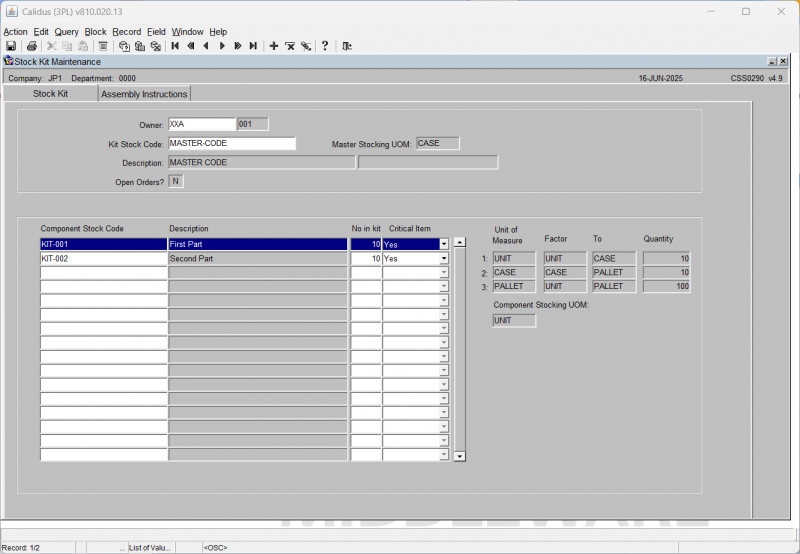
| Field Name | Description | Values |
|---|---|---|
| Owner | The owner of the Goods | LOV available |
| Kit Stock Code | The finished stock code | LOV available to display valid stock codes |
| Component Stock Code | The component stock codes. | Provide a LOV of valid stock code from the stock table. |
| Description | Description of the Stock component code | Display |
| No in Kit | The number of component stock items required to make up a kit. | Numeric field |
| Critical Item | The component stock code is a vital part of the Kit, if flagged as Yes and there is not enough available stock then the order will not be completed | Valid values are (Y) Yes or (N) No |
Assembly Instructions
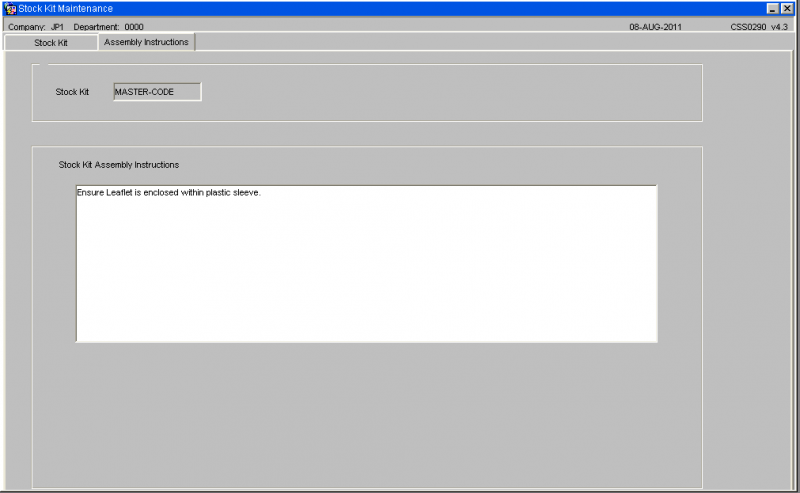
Any notes or instructions that are required to follow the order can be entered at this point.
Stock Kits Assembly Request (S0S1427)
This screen generates assembly orders to pick component parts and return them to stock as assembled kits. By clicking the ‘Kit Assembly’ button the user is able to request the number of required kits. An assembly order, with an order type of K, will be created and the order number displayed at the bottom of the screen. The order can then be allocated, pick listed and pick confirmed, but must be despatch confirmed using the Stock Kit Assembly Confirmation Screen. Stock must be pick confirmed into the dedicated assembly location set-up against the warehouse.

| Field Name | Description | Values |
|---|---|---|
| Owner Code | The code for the owner of the stock | Display |
| Kit Stock Code | The finsihed stock code | LOV available to select valid stock codes |
| Order Number | Entered once an assembly order has been created using the ‘Kit Assembly’ button | System Generated |
| Order Reference | Entered once the user has chosen to assemble a kit using the ‘kit Assembly’ button | To be entered by user - 20 Character field |
| Component Stock Code | The component stock codes. | Displays all component stock codes linked to the finshed code. |
| Description | Description of the Stock | Display |
| No in Kit | The number of component stock items required to make up a kit. | Numeric field (Display) |
| Critical Item | Whether the component stock code is a vital part of the Kit or not | Valid values are (Y) Yes or (N) No (Display) |
| Current Kits | The total number of assembled Kits | Display |
| Possible Kits | The maximum number of kits that can be assembled from the current stock holding. | Display |
| Requested Kits | Number of Kits required | Numeric Field |
| Special Instruction | Three lines of instruction of the Order | Input 40 Character field |
| Buttons | Description |
|---|---|
| Enq | By selecting any of the Enq buttons the Stock Enquiry Detail Screen for the stock code will be called |
| Kit Assembly | Selecting the Kit Assembly button will call the order form see below |
If the user clicks on the ‘Kit Assembly’ button from Stock Kits Assembly Request S0S1427, a order input screen is displayed.
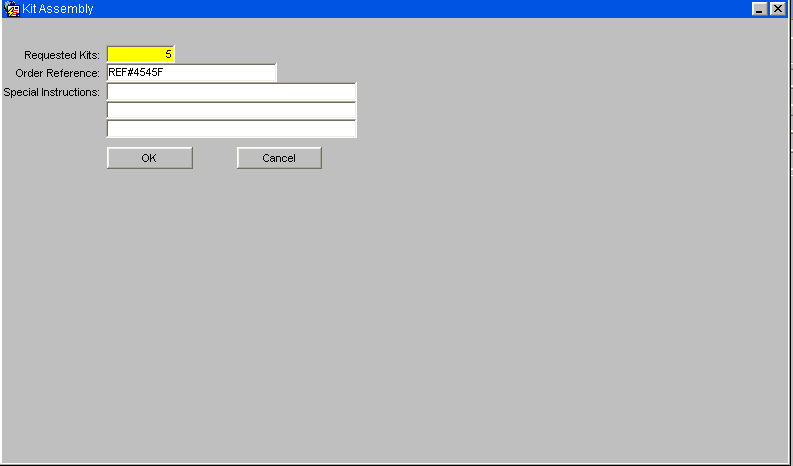
| Field Name | Description | Values |
|---|---|---|
| Requested Kits | Number of Kits required | Numeric |
| Order Reference | Customer Reference of the Order | 20 Character free text field |
| Special Instructions | Three lines of instruction of the Order | 40 Character free text field |
| Buttons | ||
| OK | The system will then create the kitting order with the information entered | Order is created with a Order Type of 'K' |
| Cancel | Cancel the data entered into the field. | Cancel the action |
Stock Kits Assembly Confirmation (S0S1428)
This screen allows the user to confirm that the order created in the Stock Kits Request Screen has been assembled into a kit.
The user is able to confirm that the components have been assembled into the kit by clicking on the ‘Confirm’ button on this screen. This will decrease the stock levels on the pallet records for the component stock items and increase the stock levels for the kit item. However, it is possible that the original order quantities for the components has been changed or that there was a shortfall of stock. Either way, the confirm procedure must recalculate the number of kits that can be assembled from the actual components picked. This may leave an excess of components. The excess components will be moved from marshalling to the assembly location, placed on hold, and dealt with by the users manually.
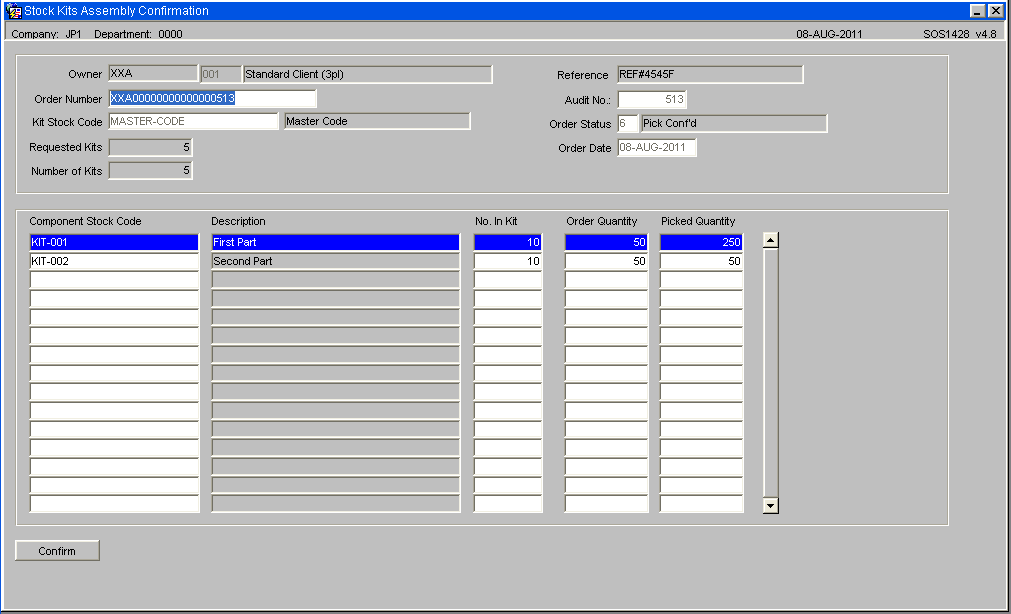
| Field Name | Description | Values | |
|---|---|---|---|
| Owner | The owner of the Goods | Depending on set up will normally be display only. | |
| Order Number | Entered once an assembly order has been created using the ‘Kit Assembly’ button | System Generated | |
| Order Status | The Order status and the description ‘Pick Conf’ | System Generated | |
| Order Date | The Date Order entered | Display - DDMMYY | |
| Kit Stock Code | The stock code in the Kit selected from the stockist code | Display | |
| Audit NO. | Unique, system generated audit number | Numeric | |
| Component Stock Code | The component stock codes. | Display | |
| Description | Description of the Stock | Display | |
| Order Quantity | The quantity ordered separated with ‘/’ for cases and units | Display | |
| Picked Quantity | The quantity ordered separated with ‘/’ for cases and units | Display | |
| Confirm | Confirms that the components have been assembled into the kit | Will downdate the component code and update the finished code with the value of the picked quantities. An audit record will also be written to IAJD. |
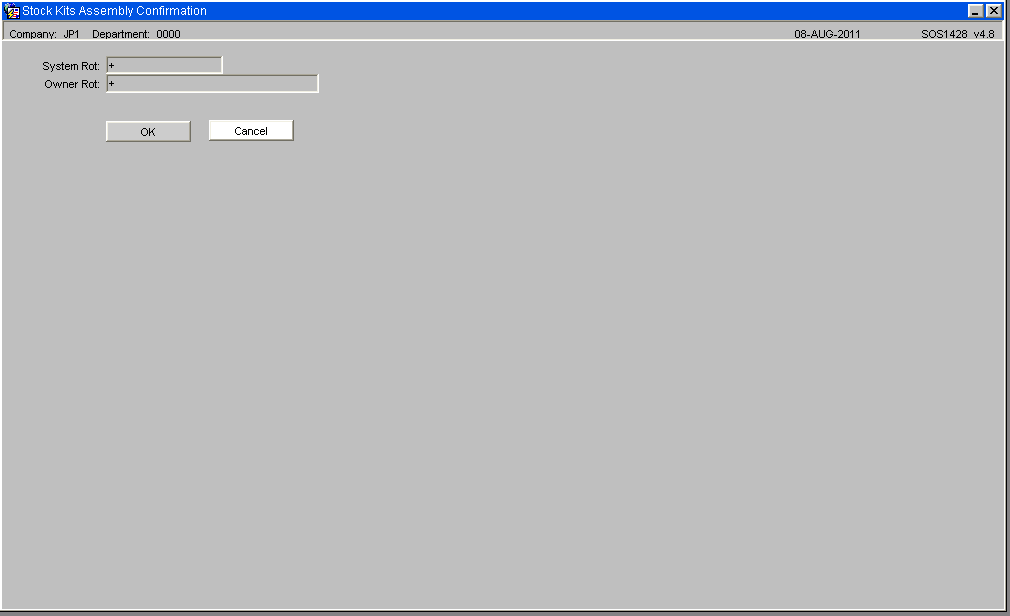
Upon confirmation it is possible to add system and customer rotation numbers if required to the finished product.
Stock Movement Enquiry (STS3000)
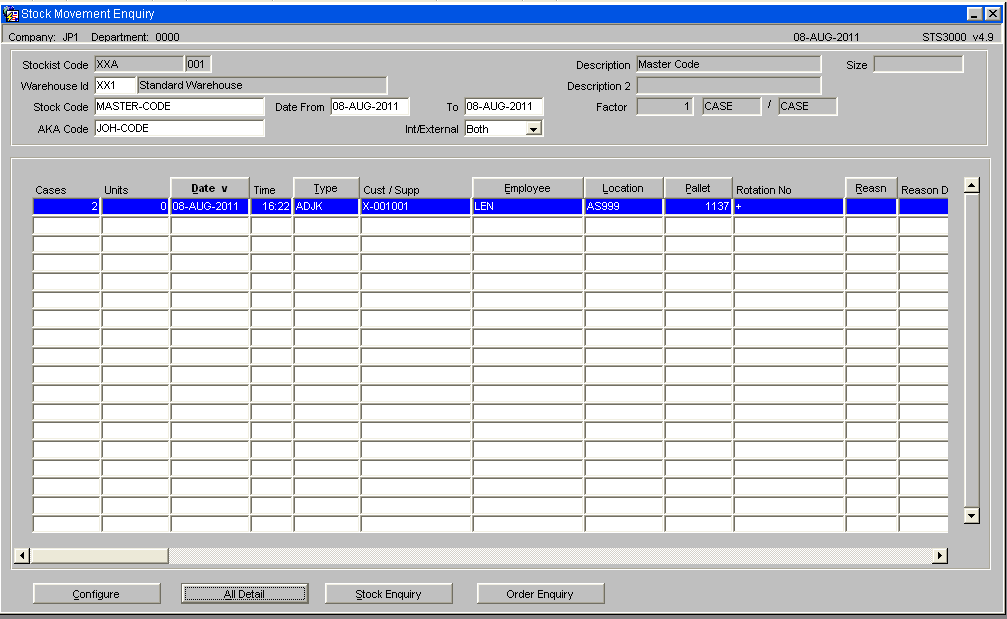
Enquiry screen showing the positive transaction, where the finished product quantity is increased.
Note: It is also possible to run the Oracle Reporting Suite for a Report Type of 'Journal' to report on relevant transactions.
Appendix A: Document History
A.1 References
| Ref No | Document Title & ID | Version | Date |
|---|---|---|---|
| 1 | |||
| 2 | |||
| 3 |
A.2 Glossary
| Term or Acronym | Meaning |
|---|---|
| Ad Hoc (WCS) | A task instigated on the device (spec. Ad Hoc Pallet Move), rather than a task instigated from the WMS and Stock Control. |
| Advice Note Number | An external reference linked to a Goods Receipt. |
| Aisle (WMS) | A component of a location; usually a space through rows of racking or storage locations; a collection of locations; |
| Allocation (order) | The systemic act of identifying and ring-fencing product matching the order requirements, following proscribed warehouse rules. |
| Anchor Point (WMS) | A starting location for a search for a suitable storage location; auto-putaway location suggestion start point. |
| Area (WMS) | A collection of aisles; an area in the warehouse for a particular purpose. |
| Batch (WMS) | A production batch of a product; a quantity of product that is considered to have the same characteristics; |
| Bay (Warehouse) | A physical loading or unloading point for the warehouse. |
| Bay (WMS) | A component of a location; usually a space between uprights in racking, comprising several levels (horizontal beams). |
| Bay Diary | The mechanism for booking hauliers inbound/outbound and assigning bays. The OBS Logistics system is CALIDUS Bay Diary. |
| Block Stack | A stable stack of pallets. |
| Booking | A time slot for a bay, booked with a Carrier/Haulier. |
| Bulk (WMS) | Bulk storage; Usually full-pallet storage areas, racked or stacked. |
| Cancellation (WCS) | The facility to cancel a task due to some problem, identified by the user when performing the task. |
| Carrier; Haulier | The transport company (by road or sea). |
| Check Digit (WMS) | A short code, usually randomly generated and stored against a location, used to help identify that a user is at the right location before they proceed with a warehouse task. |
| Container | The actual physical container, identified uniquely by the Container Number. The Container will be identified as a Container Type. |
| Container Type | Descriptive of the use and capability and physical characteristics of a container. Container types are 40ft End Loader, Reefer, etc. |
| Container Yard | The storage areas for full and empty locations in the facility. The OBS Logistics system to manage this area is CALIDUS Container Yard. |
| CSV | Character-separated values; a text file with multiple rows and values, usually separated with commas. |
| C-WCS | CALIDUS WCS, the name of the OBS Logistics Warehouse Control system |
| C-WMS | CALIDUS WMS, the name of the OBS Logistics Warehouse Management system |
| Dead Leg (WCS) | A movement of a truck without a pallet; wasted resource. |
| Despatch | The final physical stage of an order; handover of goods to the haulier. |
| De-stuffing | The act of emptying a container and storing the contents in the warehouse. |
| Drive-In | A drive-in location, typically multi-level, multi-deep location. |
| Dry Van | Any type of non-refrigerated container. |
| Dual Cycling | Processes utilizing P&D locations for interleaving tasks in and out of specific areas, reducing dead leg movements. |
| EDI | Electronic Data Interchange; any form of automatically or semi-automatically uploading or downloading information from a computer system without manually re-keying the information. |
| ERP | Enterprise Resource Planning; a system for this. |
| Exchange (WCS) | Specifically Pick Exchange or Task Exchange. The process of allowing a user to select a different pallet in a multi-pallet location and exchanging the expected pallet for this one. If the pallet is planned for another task, task exchange will complete this task instead of the expected one first. If the pallet is not planned, pallet exchange will swap the pallet (if suitable). |
| GR; GRN | Goods Receipt; Goods Receipt Number or Note |
| High Bay | Typically tall (greater than 5 level) racking, usually full pallet storage, usually Narrow Aisle. |
| Inbound (Booking) | A booking linked to a Goods Receipt. |
| JIT | Just In Time; processes designed to trigger at the last instant. |
| KPI | Key Performance Indicator. |
| Level (WMS) | A component of a location; usually the vertical compartments of an area, delineated by horizontal beams. |
| Loading | The act of loading pallets onto a vehicle. |
| Location (WMS) | A uniquely identified space in the warehouse for storage of product. There are many types, most commonly Floor locations (for example, Marshalling, Inbound), Racking or Bulk Storage Locations and Pick faces. |
| Manifest | The contents of a vehicle or container. |
| Marshalling | The act of bringing pallets for an order or load together; an area to do so. |
| Multi-deep | A location with 2 or more pallets stored sequentially i.e. only one can be accessed at a time. |
| NA (WCS) | Narrow Aisle; usually any area in the warehouse that is restricted access due to space limitations, Narrow Aisles have associate P&D locations. |
| Outbound (Booking) | A booking linked to a Sales Order. |
| P&D | Pick-up and Drop-off locations; locations used to control the handover of pallets between distinct areas, for example between chambers and the wider area of the warehouse. |
| PI; Perpetual Inventory | The act of continuously checking locations in a warehouse, identifying and correcting product quantity issues. Usually used in Bulk environments rather than Pick Faces. In pick faces, this process is called is called Residual Stock Balance and usually takes place after picking from a pick face. |
| Pick Face | A location designed for picking part of a pallet of stock. Usually a low- or ground-level location. |
| Pick List (order) | The instructions to pick pallets or cases from locations; the paper report associated to this; the stage of preparing these instructions; the sending of these instructions to WCS. |
| PO | Purchase Order. |
| Pre-advice; Goods Receipt Pre-advice | An advanced notification of what is being received. Part of a manifest. Pre-advices can be stock and quantity, or individual pallet level. |
| Putaway | The physical move of a pallet to a storage location as a result of receiving it into the warehouse. |
| RAG | Acronym for Red/Amber/Green, a traffic light colouration system depicting (in sequence) Errors, Warnings or Informational messages. Usually used in operational monitoring to effectively display when certain processes are not working as expected. |
| RDT | Radio Data Terminal. |
| Reefers | Refrigerated Containers. |
| Replen; Replenishment | The act of moving product (usually a pallet) from bulk storage to a pick face. |
| Reposition (WCS) | The facility to change the location of a movement or putaway when at the final destination, sue to some issue discovered when performing the task. |
| RF | Radio Frequency; An RF device is an RDT, typically used by CALIDUS WCS for executing warehouse tasks. |
| SCR; CR | Software Change Request. |
| Short Allocate | The process of not fulfilling an order due to failure to identify sufficient product at Allocation. |
| Short Pick | The process of not fulfilling an order due to failure to identify sufficient product when picking. May also be used as a term to indicate Short Allocation. |
| SO | Sales Order. |
| Truck Types | Plants, Mechanical Handling Equipment. For example, Reach trucks, Counter-balance trucks, pallet riders, etc. |
| UOM | Unit of Measure. |
| WA (WCS) | Wide Area; usually any area in the warehouse that is not restricted access due to space limitations, for example, floor areas, not Narrow Aisle. |
| WCS | Warehouse Control System |
| WMS | Warehouse Management System |
A.3 Document History
| Version | Date | Status | Reason | By |
|---|---|---|---|---|
| 1.0 | 08/03/2011 | Issue | Initial Version | LBW |
| 2.0 | 30/04/2025 | Issue | Updated version for formatting | ANW |
A.4 Authorised By
Matt Tipping | Aptean Project Manager | _____________________________ |
Tony Walker | Aptean Consultant | _____________________________ |
